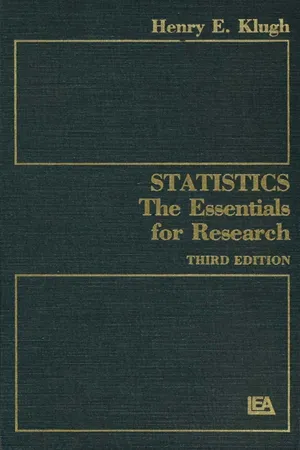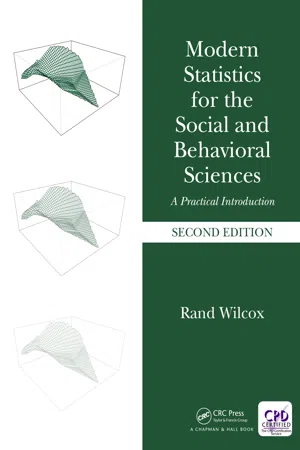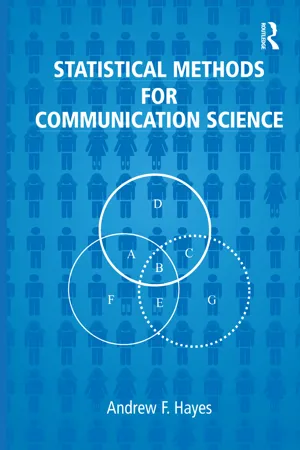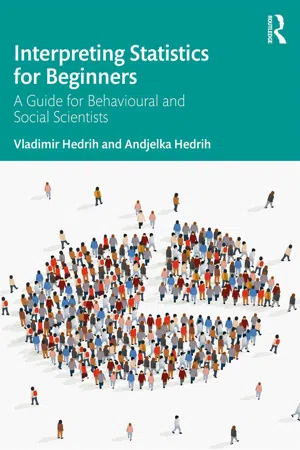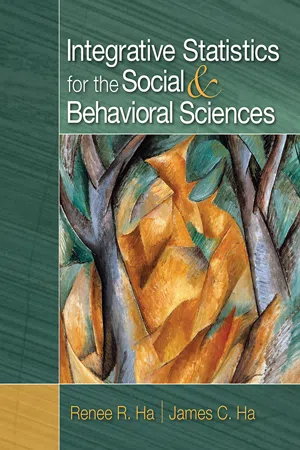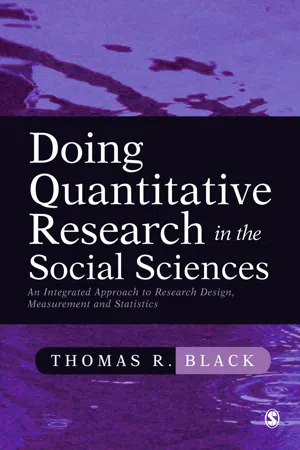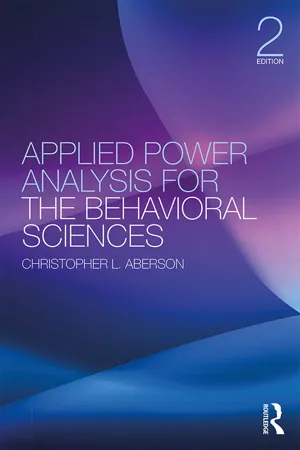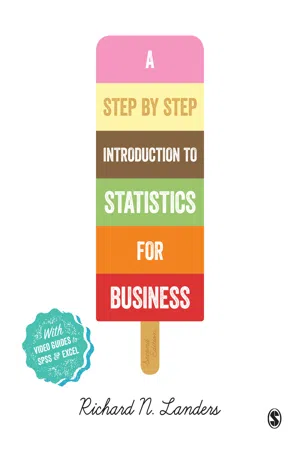Mathematics
Paired T-Test
A paired t-test is a statistical method used to compare the means of two related groups. It is typically used when the same subjects are measured twice, such as before and after a treatment. The paired t-test assesses whether the mean difference between the paired observations is statistically significant.
Written by Perlego with AI-assistance
Related key terms
Related key terms
1 of 4
Related key terms
1 of 3
12 Key excerpts on "Paired T-Test"
- eBook - ePub
Medical Statistics
A Guide to SPSS, Data Analysis and Critical Appraisal
- Belinda Barton, Jennifer Peat(Authors)
- 2014(Publication Date)
- BMJ Books(Publisher)
Chapter 4 Paired and one-sample t-testsA statistician is a person who likes to prove you wrong, 5% of the time.TAKEN FROM AN INTERNET BULLETIN BOARDObjectives
The objectives of this chapter are to explain how to:- analyse paired or matched data
- use paired t-tests and one-sample t-tests
- interpret results from non-parametric paired tests
- calculate an effect size
- report changes or differences in paired data in appropriate units
In addition to two-sample (independent) t-tests, there are also two other parametric t-tests that can be used to analyse continuous data, that is, paired t-tests and one-sample (single sample) t-tests. All three types of t-test can be one-tailed or two-tailed tests. However, one-tailed t-tests are rarely used in health sciences research.4.1 Paired t-tests
A paired t-test is used to estimate whether the means of two related measurements are significantly different from one another. This test is used when two continuous variables are related because they are collected from the same participant at different times, from different sites on the same person at the same time or from cases and their matched controls.1 Examples of paired study designs are- data from a longitudinal study;
- measurements collected before and after an intervention in an experimental study;
- differences between related sites in the same person, for example limbs, eyes or kidneys;
- matched cases and controls.
For a paired t-test, there is no explanatory (group) variable. The outcome of interest is the difference in the outcome measurements between each pair or between each case and its matched control, that is, the within-pair differences. When using a paired t-test, the variation between the pairs of measurements is the most important statistic and the variation between the participants, as when using a two-sample t-test, is of little interest. The null hypothesis for a paired t - eBook - ePub
Statistics
The Essentials for Research
- Henry E. Klugh(Author)
- 2013(Publication Date)
- Psychology Press(Publisher)
t test, uses a different formula for the standard error of the difference between means. The formula isThis is the same as Formula 11.7 except for the final term under the radicalThe r in the final term is the correlation between pairs of sample means and, as you can see, any positive correlation reduces and increases the value of t. In the next few paragraphs we will give some examples requiring the use of a matched pairs t test and then we shall describe a computational short cut for calculating it.Suppose we are interested in the change in weight of adult males from one generation to the next. We might let be the sample mean of weights for 20-year old first-born sons and be the sample mean of their father’s weights at age 20. If we were able to draw many pairs of such means we would expect to find a fairly substantial correlation between the pairs. This research, if we could obtain the data, would use a matched pairs t test to determine the significance of the difference between the means.Here is another example with a somewhat different procedure. We may wish to establish the equivalence of an experimental and a control group by matching or equating subjects on some variable highly correlated with the dependent variable. Suppose we wish to determine if procedure A produces more rapid learning than procedure B. Imagine that we have a population of potential participants who have taken a test of learning ability. We arrange these individuals in the order of their scores on the test and then, beginning with the highest pair and continuing with each descending pair, we randomly assign one member of each pair to procedure A and the other to procedure B - eBook - ePub
- Daniel B Wright, Kamala London(Authors)
- 2009(Publication Date)
- SAGE Publications Ltd(Publisher)
6
Hypothesis Testing: t Tests and AlternativesComparing Two Groups (Assuming Equal Variances) Not Assuming Equal Variances: Acupuncture Wilcoxon and Mann–Whitney–Wilcoxon Tests as Distribution-Free AlternativesThe Paired t Test: Introducing Null Hypothesis Significance TestingTests for Medians Summary Exercises Further ReadingMann–Whitney–Wilcoxon Test: An Alternative to the Between-Subjects t TestChapter 5 described how to compute confidence intervals for means, medians, and differences between means and medians. These allow you to create a band within which you are confident that the population values (for the mean, median, and differences between means and medians) lie. In some situations there are values that are of specific interest. In these cases scientists might wish to test whether the observed data are likely to have arisen if the population mean (or median or difference) was this value. An example is if the difference between two means is zero. In this chapter you are taught two t tests, devised by ‘Student’, who you were introduced to in Box 4.2 . The first of these is that there is no difference between the means of two variables for a group of people. It is called the paired t test. The second is that there is no difference in the means of a variable for two groups. This is called the group t test. We also discuss alternative procedures which have fewer assumptions than these t tests.THE PAIRED t TEST: INTRODUCING NULL HYPOTHESIS SIGNIFICANCE TESTING
In the coffee preference example from Chapter 5 there is a special interest in the value zero for the difference. If the mean in the population were zero this would mean that overall both coffees are preferred equally. Some people may prefer the fresh coffee from Brewed Awakenings more, but others will prefer the instant coffee from the mini-mart. One way to explore the coffee data is to assume that the population mean for the difference is zero and to test how likely it would be to observe data as extreme as observed. This general approach is called null hypothesis significance testing (NHST). You hypothesize a certain value for the population, usually that a difference is zero, and then you see whether the observed data look too extreme to have arisen from this hypothesized population. The particular test used in this situation is a paired t test (also called related t test, matched t test and within-subject t test). This was the first significance test devised by ‘Student’/Gossett in 1908. Since then significance testing has become the most common approach in the social and behavioural sciences, although it is controversial (see Box 6.1 - eBook - ePub
Modern Statistics for the Social and Behavioral Sciences
A Practical Introduction, Second Edition
- Rand Wilcox(Author)
- 2017(Publication Date)
- Chapman and Hall/CRC(Publisher)
Assuming normality, this latter hypothesis can be tested by applying Student’s T using the differences D 1,....,D n. To make sure the details are clear, the following summary of the paired T test is provided. Goal: For two dependent groups, test H 0 : μ 1 = μ 2, the hypothesis that they have equal means. Assumptions: Pairs of observations are randomly sampled with each group having a normal distribution, in which case D has a normal distribution as well. Computational Details: Compute the mean and sample variance of the Di values:. and D ¯ = 1 n ∑ i = 1 n D i and s D 2 = 1 n - 1 ∑ i = 1 n (D i - D -) 2 Next, compute the test statistic T D = D ¯ s D / n. The critical value is t, the 1 - α /2quantile of Student’s t distribution with ν = n– 1 degrees of freedom. Decision Rule: The hypothesis of equal means is rejected if | TD | ≥ t. Confidence Interval: A 1 - α confidence interval for μ 1 — μ 2, the difference between the means,. is D ¯ ± t s D n. As just indicated, the paired T test has n — 1 degrees of freedom. If the groups are independent, Student’s T test (in Chapter 7) has 2(n – 1) degrees of freedom, twice as many as the paired T test. This means that if we compare independent groups (having equal sample sizes) using the paired T test, power will be lower compared to using Student’s T in Chapter 7. However, if the correlation between the observations is sufficiently high, the paired T test will have more power. That is, given a choice when designing an experiment, comparing dependent groups is preferable to comparing independent groups. To provide an indication of why, it is noted that when pairs of observations are dependent, the squared standard error of the difference between the sample means is V A R (X ¯ 1 - X ¯ 2) = σ 1 2 + σ 2 2 - 2 ρ σ 1 σ 2 n, where σ 1 2, and σ 2 2, are the variances associated with groups 1 and 2, respectively - eBook - ePub
Improving the User Experience through Practical Data Analytics
Gain Meaningful Insight and Increase Your Bottom Line
- Mike Fritz, Paul D. Berger(Authors)
- 2015(Publication Date)
- Morgan Kaufmann(Publisher)
Again, whether we are comparing the mean satisfaction with the two designs or the mean time it takes to perform a task with the two designs, there is no material difference in the analysis. That is, the software does not know, nor care, nor can it distinguish, whether the numbers are representing satisfaction scores, or whether the numbers represent times to perform a task.Now, it may not be obvious why it matters whether we have independent samples or paired samples. While you can rest assured that it does matter (and the software does the right—but a bit different—process when told whether the samples are independent or paired), we will address this issue in more detail later in the chapter to give you a better sense of why it matters.3.4. Example of Paired (Two-Sample) t-test
When we are comparing two means and the data have the same people providing measurements of both alternatives (the satisfaction rating of two designs, or the time for the performance of some task for two designs), we have what are referred to as “paired data.” The term makes sense, in that a data point from one alternative is identifiably “paired” with a data point from the other alternative. As we stated earlier, this makes a difference in the precise way we perform the t-test. The hypotheses are the same as in the previous chapter:Another way to notate the “pairing” of the data is by changing the above notation toH 0 : μ 1 = μ 2H 1 : μ 1 ≠ μ 2H 0 : μ 1 − μ 2 = 0H 1 : μ 1 − μ 2 ≠ 0 ,and define D = μ1 − μ2, where D stands for “true average difference” (for the same person using the two alternatives) and writingH 0 : D = 0H 1 : D ≠ 0In other words, is the (true) average difference (D) between the time it takes a person to perform the two tasks zero (H0 is true) or not zero (H0 is false, H1 is true)? Recall from Chapter 1 that if we accept H0 (concluding that H0 is true), this really is saying that there is insufficient evidence to reject H0.Let’s illustrate the “paired-data t-test” using our job posting timing data for design 1 (“The Long Scroller”) and design 2 (“The Wizard”). The particular data set has 10 people using each of two designs, and to ensure there is no “learning curve effect,” we randomly had 5 of the participants use design 1 first and 5 of the participants use design 2 first. The 20 data points—recall that these data represent 10 participants using each of the two designs—are in Table 3.1 - eBook - ePub
Statistics for the Behavioural Sciences
An Introduction
- Riccardo Russo(Author)
- 2004(Publication Date)
- Psychology Press(Publisher)
Chapter 9 Comparing a pair of meansThe matched- and the independent-samples t-testIntroduction
In Chapter 8 we mainly described how to decide if a set of observations was drawn from a given population. We showed how to apply the t-test in assessing the probability that a set of observations, with their observed mean, was drawn from a population with a given mean. In that chapter we also showed how to use sample data to construct confidence intervals that have a given probability of containing the true population mean. In this chapter we will extend the application of the t-test to situations in which we intend to compare the means obtained from two sets of observations. The aim of this comparison is to decide if the two sets are sampled from the same population or not.If the outcome of the t-test gives a sufficiently small probability of the two sets of observations being drawn from the same population, then we declare that the two sets of observations are drawn from different populations (i.e., there is a significant difference between the means). Two different conditions in which the t-test is applied to compare a pair of means will be described:- when the means are obtained from two sets of related observations; and
- when the two sets of observations are independent.
We also explain how to construct confidence intervals for the difference of a pair of population means, and we describe the conditions where the t-test may not be appropriate for comparing pairs of means. This occurs when some of the assumptions underlying the use of the t-test are violated. For these cases we indicate alternative ways to analyse the data. Given the strong similarity to the one-sample t-test, we first describe the application of the t - eBook - ePub
- Andrew F. Hayes(Author)
- 2020(Publication Date)
- Routledge(Publisher)
t in the direction obtained (assuming that the obtained result was in the direction predicted).This method of computing the p-value makes no assumptions at all about the shape of the population distribution on whatever is being measured, so it can be confidently used in a sample from any population regardless of the sample size. However, it is computationally tedious and very few statistical programs used by communication researchers include bootstrapping methods for computing a p-value.9.2 Comparing the Means of Paired Responses
In the previous section, I introduced the one-sample t test for testing a hypothesis about the value of a population mean. Although understanding the logic of the test is important, the fact is that this test, at least in the form described above, is not widely used. This is because communication research often revolves around questions about comparisons between groups of people or between measurements over time. But there is a version of the one-sample t test that is widely used for a particular category of research designs.9.2.1 The Paired-Samples t test
Consider a scenario where a single sample of participants is measured at 2 different times on the same variable, between which each person in the sample is asked to engage in some kind of task. For example, the participants might watch a political advertisement, or they may watch a certain TV show between the two measurement periods. Is it often of interest to know whether there has been any change between the 2 times on the variable being measured. Such a research design is called a single-group pretest posttest design (Shadish, Cook, & Campbell, 2002). Or consider comparing 2 research units that are paired through some kind of social connection, like mother-daughter, husband-wife, or boss-subordinate, with the goal of seeing whether the 2 units differ from each other on average on some variable. Such a research design is called a matched-pairs design. For example are husbands more argumentative than their wives? To conduct this study, you might administer Infante and Rancer’s (1982) Argumentativeness Scale to 30 husband-wife pairs and test whether the mean argumentativeness score for husbands is different from the mean for the wives. We can test a hypothesis about the size of the average difference between measurements that are paired in some fashion with the dependent groups t test, also called the paired t test, or the matched-pairs t test. The name comes from the matching or pairing of the measurements. Each measurement in the data is paired or matched with another measurement in the data. For example, in the single-group pretest posttest design, a person’s measurement at time 1 is paired with his or her measurement at time 2. In the matched pairs design such as described above, the husband’s measurement on the argumentativeness scale is paired with his wife’s measurement on the same variable. Although the test goes by a different name when analyzing data from such designs, as you will see, this test is nothing more than a one-sample t - eBook - ePub
Interpreting Statistics for Beginners
A Guide for Behavioural and Social Scientists
- Vladimir Hedrih, Andjelka Hedrih(Authors)
- 2022(Publication Date)
- Routledge(Publisher)
smaller effect sizes to reject the null hypothesis or smaller sample sizes for the same effect size to reach statistical significance than tests for independent samples. In other words, they typically have higher power compared to tests created for independent samples.7.2 Comparing two means – t test
The t test is a parametric test created for determining whether two samples come from populations with the same value of the arithmetic mean. This is done by testing the null hypothesis that the difference between means of two populations is zero. This is based on the calculation of a standard error of the differences of the mean and then dividing the obtained difference between sample means with the standard error of difference between sample means. As with all standard errors, standard error of difference between means then depends on the variability of the samples on which they were calculated (i.e. their standard deviations/variances) and on sample size. The larger the sample and the smaller the variability of values of entities in both samples, the smaller the standard error of difference between means will be. The difference between means is than calculated and divided by this standard error of differences between means and the result obtained in this way is called the t statistic. The t statistic is than used to estimate the probability of obtaining the difference between means as was obtained between these two samples or larger when the difference between population means is 0 and this probability is the statistical significance of the t test. If the result of the t test is statistically significant i.e. if p is lower than the accepted threshold of statistical significance (most commonly .05), we can reject the null hypothesis and conclude that samples do not come from populations with the same mean on the examined variable. On the other hand, if the value of statistical significance is above the accepted threshold, we accept the null hypothesis and conclude that there is insufficient evidence that population means are not the same (i.e. we will treat them as if they were the same). - Renee R. Ha, James C. Ha(Authors)
- 2011(Publication Date)
- SAGE Publications, Inc(Publisher)
Once again, we have placed the numbers that are comparable to our manual calculations in bold. And once again, you see that calculated probability (.026: SPSS calls it “Sig. 2-tailed”) is less than our alpha level of 0.05, and thus we must assume that these results are unlikely due to chance and thus are more likely a result of time since the event.How would these results be reported in a scientific journal article?
If the journal required APA format, the results would be reported in a format something like this:There was a significant difference in the rate of nest visits between the undisturbed location (M = 6.79, SD = 1.94) and the construction location (M = 5.59, SD = 1.81), t(6) = 2.95, p = .03.This formal sentence includes the dependent variable (rate of nest visits), the independent variable (two different locations), the direction of the effect as evidenced by the reported means, as well as a statement about statistical significance, the symbol of the test (t), the degrees of freedom (6), the statistical value (2.95), and the estimated probability of obtaining this result simply due to chance (.03).When is it appropriate to use a paired t test?
1. When you have two samples and a within-groups design2. When the sampling distribution is normally distributed, which, as you should recall, is satisfied whena. The sample size is greater or equal to 30 (n ≥ 30) orb. The null hypothesis population is known to be normally distributed.3. When the dependent variable is on an interval or ratio scaleINDEPENDENT t TEST
In the previous section, we described a situation where your two conditions contain either the same subjects or subjects that have been individually matched on an important characteristic that might potentially influence the outcome of your results and is not interesting to you (age or body weight are potential examples of characteristics that you might match subjects on). This is referred to as a within-groups design. Now we turn to the situation where you actually have two completely different (independent) groups of subjects that you want to compare to determine if they are significantly different from one another: a between-groups design. The classic example of this is when you have a sample and you randomly assign half of your subjects to the control condition and the other half to the experimental treatment condition. In this situation, we wish to compare the means of the two conditions/groups. We can no longer assume that we know a population mean (as we did when we assumed that the µD= 0 in the paired t- eBook - ePub
Doing Quantitative Research in the Social Sciences
An Integrated Approach to Research Design, Measurement and Statistics
- Thomas R Black(Author)
- 1999(Publication Date)
- SAGE Publications Ltd(Publisher)
Thus for the same difference in the two means, the potential power of the test will decline slightly if one has to compensate by modifying the test. Ultimately we will consider four versions of the t -test in this chapter, and others under nonparametric tests for comparing two groups in Chapters 19 and 20. In this chapter, you will be able to set up a simulation to explore the relationship among these assumptions and compare outcomes for different situations. You will also have at the end a worksheet into which you can enter raw data and generate the results for any one of the four tests, including an assessment of the power of each. From One Group to Two Having established a way of determining the likelihood of a sample belonging to a known population rather than a separate unknown one, it would seem that this could be extended to comparing two samples. There are definite similarities and the issue is much the same: if we have two samples, do they belong to one population or do they belong to two separate ones for the trait in question? For example, two random samples of employees are selected, one provided with a programme of motivation counselling to improve self-image and therefore productivity, and a second control group. Both groups respond to a written instrument to measure self-image both before and after the treatment period. At the end of the study, do both groups belong to the same population for the characteristic of interest, self-image, based on gain scores on the instrument? Assuming all extraneous variables were controlled, did the counselling have any effect and make them different? When testing the question of whether a sample belongs to a known population, the sample mean is compared to a distribution of possible sample means to see if it is within an acceptable range, often the 95% range of, the standard error of the mean (SEM) - eBook - ePub
- Christopher L. Aberson(Author)
- 2019(Publication Date)
- Routledge(Publisher)
3INDEPENDENT SAMPLES AND PAIRED t-TESTSThis chapter focuses on power for designs traditionally addressed using t-tests (either independent or paired). These procedures often examine treatment-control group comparisons and pre-post designs. I present power analyses for independent and paired designs with R functions for primary analyses and for tests addressing violation of homogeneity of variances assumptions and unequal sample sizes.Necessary Information
For designs using independent sample t-tests, the initial step is determining means (μs) representing meaningful differences between groups and making a reasonable estimate of standard deviation (σ) for both groups. For paired t-test designs, means representing meaningful differences, standard deviation, and the expected correlation (ρ) between dependent measures are required. For the paired t-test, the standard deviation of the difference may be substituted for σ and ρ; however, it is usually easier to focus on standard deviations and the correlation.For both tests, you may also start with an estimate of the effect size. The effect size estimate most commonly used for two-group designs is Cohen’s d. Technically, power analysis involves a population effect size, which is usually noted as δ or Δ (lower- and upper-case delta, respectively). This text uses d to designate the population effect size. This is because δ represents the noncentrality parameter (NCP) (discussed in the next section), and it is confusing to use the same symbol for two different values.Estimation of the standard deviation deserves special mention. Estimating the population standard deviation (σ) is sometimes tricky. One approach is to pretest. In general, a pretest with even as few as 20 participants helps to establish a reasonable estimate of variability for the dependent measure.1 - Richard N. Landers(Author)
- 2018(Publication Date)
- SAGE Publications Ltd(Publisher)
Paired data are not necessarily from repeated measures. Another common type of paired data comes from interpersonal relationships. For example, if we ran a toy retailer, we might want to know if there were differences in attitudes to our toys between parents and their children in order to better target our marketing efforts. If we bring pairs of a parent and their child to interact with a toy and rate it, we have created paired data. However, it’s important to note that the relationship itself is not what makes this a paired design; instead, it is the way we collected the data. If, instead, we had randomly sampled parents and randomly sampled children separately, this would not produce paired data (since there would be no pairs).9.2 Hypothesis Testing with Paired Data
Hypothesis testing with paired data is not altogether different from hypothesis testing in one-sample t-tests. There are only a few key differences, which I’ll highlight as we step through the process. We explore this chapter’s case study dataset to examine these issues. Here’s a summary of that dataset as it relates to paired data:- Variable 1: type@hire – Typing speed at employment (in words per minute).
- Variable 2: type@6mos – Typing speed after six months (in words per minute).
- Variable 3: satis@hire – Office work satisfaction at employment.
- Variable 4: satis@6mos – Office work satisfaction after six months.
- n = 151.
9.2.1 Paired Data Hypothesis Testing: Step 1 (State the Research Question)
With Chapter 8
Index pages curate the most relevant extracts from our library of academic textbooks. They’ve been created using an in-house natural language model (NLM), each adding context and meaning to key research topics.
Explore more topic indexes
Explore more topic indexes
1 of 6
Explore more topic indexes
1 of 4

